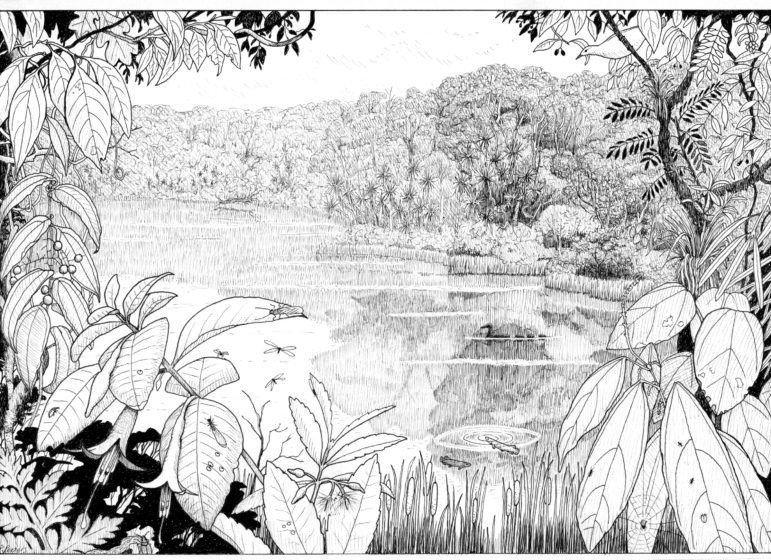TWH – Twenty-three million years ago, the Miocene Epoch had levels of atmospheric carbon dioxide similar to those predicted for later this century. That distant past might offer insights for the near future. A recent study found that plants of that epoch had adapted to those high levels of atmospheric carbon dioxide.

Foulden Maar Artist’s Reconstruction by Paula Peeters – Artist’s blog, CC BY 4.0
The Wild Hunt spoke with Animist and biochemist, Felicity Grove, about that study.
Grove blends her Animist practice and values with those of science. She begins with the sanctity of Nature. “Everything in Nature is sacred,” Grove continued, “Evolution is the mechanism by which nature alters and adapts to changes.”
It helps to maintain “homeostasis,” which the Merriam-Webster online dictionary defines as “a relatively stable state of equilibrium … between the different but interdependent elements or groups of elements of an organism, population, or group.”
“When something disturbs that balance,” Grove continued, “then something else that is in that balance is also disturbed. The Earth is one humongous homeostasis. Everything on Earth is in it.”
A change to one thing impacts many other interdependent parts. When atmospheric carbon dioxide levels, rise, it impacts everything else. This scientific concept may remind some Pagans of the non-scientific concept of the Web of Life.
”Nature will find a new balance point.” Grove said, “Our understanding of prehistory shows that [there] have already been a number of these readjustments to find new balance points.”
Grove cited mass extinction events, as an example. “Nature doesn’t show favoritism … The new balance point may not include humans.”
The findings of the study
Grove described the study’s findings, “Scientists have found beautifully preserved (mummified) leaves that have structures that show the adaptations plants needed when carbon dioxide levels rose. Why is it interesting? Because these leaves lived in [a] period of Earth’s history called the Miocene Epoch which took place 23 million years ago.”

Foulden Maar leaf fossils – Image credit: Kimberley Collins – CC BY-SA 4.0
In the Miocene Epoch, the atmosphere had 450 to 550 parts per million (ppm) of carbon dioxide. Before humans began to use fossil fuels, levels of atmospheric carbon dioxide were 300 ppm. Those levels have now risen to 410 ppm. They are still rising.
Near Dunedin, New Zealand, scientists drilled into Foulden Maar, a dry lakebed. They drilled down to about 183 m (roughly 600 ft) and found fossilized leaves. Once those leaves had been part of a subtropical evergreen forest. The fossils preserved the veins, pores, and stomata of those leaves.
“The scientists studying these ‘mummified’ leaves found that they were better adapted to the higher carbon dioxide levels.” Grove continued, “They had a more efficient way to use water. All plants have a delicate balance of opening up special pores called stoma which actually do open and close. The balance is how wide to open; wide enough for carbon dioxide to enter but closed enough to stop water evaporating out. These adapted Miocene plants were able to use the water more efficiently. Exactly how is complicated.”
Grove described an effect of increased efficiency. “We already know that more atmospheric carbon dioxide means more biomass. More efficient water use by plants means being able to grow in dryer conditions and also [to] tolerate drought.”
Implications of that study
According to Grove, this study adds to our understanding of the impact of increased atmospheric carbon dioxide. She said, “It has implications for our own time now. The recent rise in carbon dioxide in the atmosphere has been pretty steep. If we continue the way we are using fossil fuels, scientists have calculated that the levels of carbon dioxide will be just like [they were] in the Miocene.”

Foulden Maar Pit – Kimberley Collins – CC BY-SA 4.0
By 2040, scientists expect those levels to reach 450 ppm. Grove said that those levels would produce higher temperatures with all their associated problems. That means more frequent and intense droughts, hurricanes, and wildfires. It will also mean less landmass as sea levels rise.
Grove said that the article was positive for plants. “They have the ability to adapt. Rising carbon dioxide levels could mean a greening of the planet – plants being able to reforest where the climate was too dry.”
She continued, “It shows that at a time when atmospheric carbon dioxide levels were at the level we are currently heading for, some plants, back in Miocene, were better able to use water more efficiently. It means that if some of the plants today have a similar adaptation, higher carbon dioxide could mean more plants in more arid areas which means more Green. That’s all. And that’s a good thing.”
Grove felt optimistic for nature, “Nature can take this situation of higher carbon dioxide levels and effectively go, ’Meh, sure, I can deal with that. I’ve done it before. I can do it again. Probably have to lose a few species in the process. But what the heck, ‘cause some more new species will appear.’ Life will carry on. Extinction of species just might include the [extinction of that] one species responsible for fucking it up for the 200 species that are lost each freaking day, and that one species is us humans.”
Climate of the Past has published a full report on that study, and while that report is fairly technical, the BBC published a more accessible story about it.
The Wild Hunt is not responsible for links to external content.
To join a conversation on this post:
Visit our The Wild Hunt subreddit! Point your favorite browser to https://www.reddit.com/r/The_Wild_Hunt_News/, then click “JOIN”. Make sure to click the bell, too, to be notified of new articles posted to our subreddit.